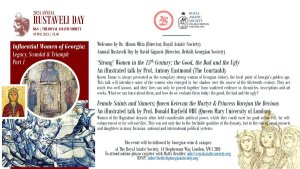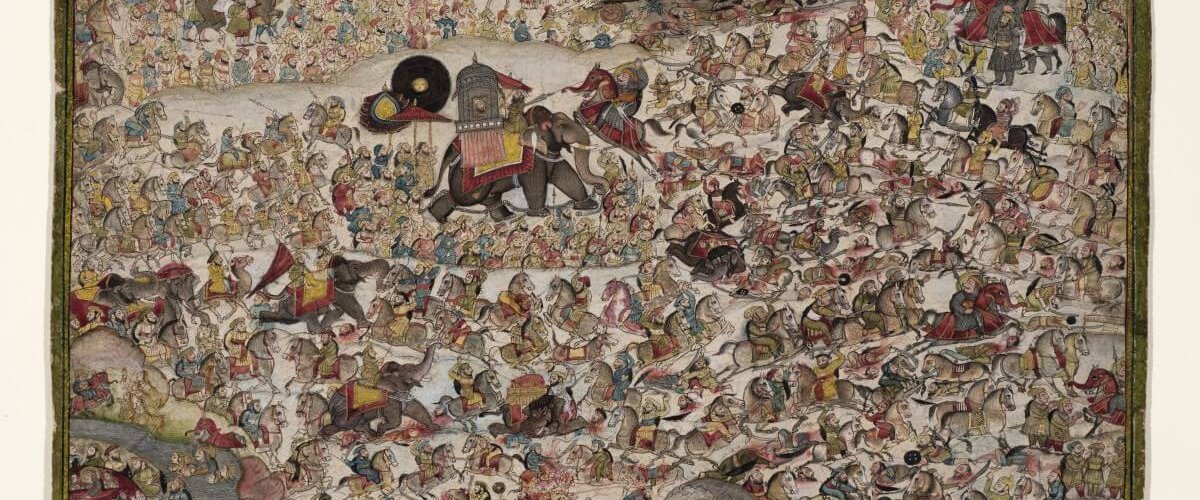Joe Cribb, recently honoured at the Society, has an article in the latest Journal of the Royal Asiatic Society
We are delighted to announce that the latest edition of the Journal of the Royal Asiatic Society is now available online Cambridge University Press. All Fellows of the Society can access the articles using their login on our website. For those not yet Fellows, some of the articles are available via open access.

Within the latest edition is an article by Joe Cribb, whose 75th birthday and accompanying publication, Look at the Coins! Papers in Honour of Joe Cribb on his 75th Birthday, we celebrated at the Society two weeks ago. Joe, an expert in Kushan history, has written on A Kushan royal inscription among the Almosi rock inscriptions recently discovered in Tajikistan, in which he positions a new inscription in the name of the Kushan king, Wima Takto (c. 90-113CE), recently discovered by archaeologist Muhsin Bobomulloev of the National Museum of Tajikistan and his colleagues, within the current understanding of Kushan history and the status of Wima Takto. The new inscription, found in the Almosi Gorge with other inscriptions in an ‘unknown script’, confirms the identity of Wima Takto, the second king of the Kushan Dynasty which ruled a large territory stretching from Central Asia to North India in the first four centuries CE. The history of this dynasty is pieced together from inscriptions, coins, and archaeology, and fleeting references in Chinese sources. Each new inscription adds another piece to the jigsaw of Kushan history, revealing a powerful state in control of the central lands of the ancient Silk Road.
Of course, one article does not make a Journal. Below are a list of the other articles with their abstracts:
The Naqshbandiyya Mujaddidiyya in China by Rian Thum. This article is available via open access.
The Naqshbandiyya Mujaddidiyya order is among the world’s largest and most geographically widespread Sufi orders, but it has long been assumed to be absent among Chinese-speaking Muslims. Despite a handful of isolated references to local Chinese Mujaddidī groups in studies of particular communities, comprehensive histories of Chinese Islams make no mention of the Mujaddidiyya, and histories of the Naqshbandiyya Mujaddidiyya make no reference to Chinese-speaking Muslims. This article demonstrates that the Mujaddidiyya order has not only been present at various times and places among Chinese Muslims, but has also played a role in the development of nearly all major strains of Islam in China proper, including those commonly known as the Gedimu, Jahriyya, Khāfiyya, Qādiriyya, and Ikhwān. The article also uses new primary sources to provide an account of how a Mujaddidī order expanded into Eastern Turkistan and was transmitted from there to Muslims in China proper. It shows that adaptation to local environments created distinctive forms of Mujaddidī Sufism, highlights Hui-Uyghur connections, and argues that South Asia deserves a central place in any account of Islam in China.
Comparison constructions in two Northern Talyshi dialects by Hakob Avchan
This article examines the comparison constructions in two Northern Talyshi varieties: in Anbarāni, used in the Islamic Republic of Iran; and the Northern Talyshi dialects spoken in the Republic of Azerbaijan. These constructions have been poorly studied in previous research dealing with this North-western Iranian language and this article aims to fill that gap. In contrast with a number of Western Iranian languages, Northern Talyshi (and the Talyshi language in general) does not have special morphological markers for expressing the degrees of comparison. The comparative grades are marked syntactically using various adpositions and function words. Having long been under the influence of neighbouring languages such as Persian and Azerbaijani, both Anbarāni and the Talyshi dialects spoken in the present-day Republic of Azerbaijan have been affected by these languages at some level in the ways to make comparison
‘From all quarters of the Indian world’: the temple at Rameshvaram, Hindu kings, and Dutch merchants by Lennart Bes and Crispin Branfoot. This article is available via open access.
On Rameshvaram island in the south-east corner of India lies one of Hinduism’s most important temples—the Rāmanāthasvāmi, one of the four dhams (‘holy abodes’) and the site of two Śiva-liṅgas said to have been consecrated by Rāma himself. A temple has existed here since at least the eleventh century, although most of the present temple dates to the seventeenth and eighteenth centuries when the island was protected by the Setupati rulers of nearby Ramnad. In several of the long corridors and halls for which this temple is famous are brightly painted life-sized standing images of over 100 male figures attached to columns. Though such images are characteristic of many south Indian temples from the seventeenth and eighteenth centuries, there are far more at Rameshvaram than at any other south Indian temple. This article examines the number, location, and significance of these numerous standing images within this temple. By exploring the significance of the temple as a long-standing site for the royal performance of devotion, this article seeks to address whether the great number and identity of the life-sized donor images can be explained by both Purāṇic ideas of kingship and seventeenth- and eighteenth-century Dutch observations of the pan-Indian status of the temple.
The Tang legacy on the Silk Road during the Uighur era: urbanisation in the eastern Tianshan region during the ninth to thirteenth centuries by Ma Fu
Tang expansion in the early seventh century brought about a series of changes to the eastern Tianshan region, including the incorporation of the region into the imperial postal relay and defence system. Important structures, including cities for the soldiers and other immigrants from Tang territory, along with fortresses and relay posts, were established along the major routes in the region, especially on the northern slopes of the Tianshan range. However, the era after the decline of the Tang is not as well known, due to a lack of contemporary sources. This article, based on a comprehensive analysis of documentary and unearthed materials, discusses a previously unacknowledged process of urbanisation in the region during the Uighur era. Uighur immigrants, originally nomads on the Mongolian steppe, occupied not only the cities, but also the garrisons and other infrastructure established by the Tang. As a result, urban settlements were established at sites that had previously served military purposes. Clusters of new cities emerged in the region, especially on the northern slopes of the Tianshan, which had long been part of the nomadic cultural zone. The sedentary and mercantile culture of the Uighurs played an important role in this process, serving as an impetus for economic prosperity along the eastern section of the Silk Road between the Tang and Mongol–Yuan eras.

Kṛṣṇa the Magician: metapoesis and ambivalence in Faiḍī’s Mahābhārat by Justin N. Smolin
In this article, I discuss the vilification of Kṛṣṇa as a deceitful sorcerer in the Mughal poet-laureate Shaikh Abū’l Faiḍ bin Mubārak, or ‘Faiḍī’s Mahābhārat and his correspondent apotheosis as the ‘essence of the True God’ in the Shāriq al-maʿrifat, a treatise also ascribed to Faiḍī. As I argue, this inconsistency, or ambivalence, is a common and overlooked facet of the elite Islamicate engagement with religious diversity and difference in early modern Hindustan. In the case of the Mahābhārat, however, Faiḍī’s portrayal of Kṛṣṇa as a deceitful illusionist reflects not only an Islamic discomfort with Vaishnavite theology, but Faiḍī’s own performative insecurities as a Hindustani writer of Persian poetry and literary prose. Kṛṣṇa’s so-called ‘magic’ lies in large part in his way with words: the verbal and social manipulation he uses to stoke the flames of conflict. The character thus becomes a kind of shadow or double of Faiḍī himself-a demiurgic author of the Mahābhārat upon which the poet can displace the classical Islamicate association of poetry with sorcery and deceit.
Foreign aromatics, olfactory culture, and scent connoisseurship in late medieval China by Lind Rui Feng. This is available via open access.
By the end of the Tang Dynasty (618–907 CE), olfactory culture in China had evolved significantly as coveted aromatics continued to be imported and in increasing quantities from Southeast Asia. Although there is no surviving treatise dedicated to aromatics from this period, anecdotes in prose literature describing the uses and curation of scents reveal a process in which imported aromatics were being actively incorporated into existing olfactory culture and accrued new social, aesthetic, and ritual significance. This process is discernible in two major respects. First, a discourse of connoisseurship for aromatics arose in contrast to the conspicuous consumption of imported aromatics that flaunted wealth and status. Secondly, aromatics that were once the privilege of the very few began to be circulated among a wider (admittedly still elite) population, as seen in the case of the dragon brain aromatic in late-Tang and Five Dynasties accounts. By delving into these and related prose narratives and by cross-examining these accounts against other types of records, this article examines how imported aromatic goods shaped the Tang elite’s perception of how scent was—and could be—used as part of a socially rooted sensory experience.
New dawn in Mughal India: longue durée Neoplatonism in the making of Akbar’s sun project by Jos Gommans and Said Reza Huseini
In this article, we explore the longue durée philosophical background of Mughal Emperor Akbar’s sun worship. Although Akbar’s sun project may have been triggered by contemporary Hindu and Zoroastrian ideas and practices, we argue that Akbar’s Neoplatonic advisers reframed it as a universal cosmotheistic tradition that, at the start of the new millennium, served as the perfect all-inclusive imperial ideology of Akbar’s new world order. The astonishing parallels with the much earlier Neoplatonic sun cult of Roman Emperor Julian demonstrate that, although having characteristic of its own, Akbar’s sun project was not that unique and should be seen as a fascinating late example of a so-far completely forgotten ancient Neoplatonic legacy of seeing the philosopher king, via the Sun, via illumination, connected to the One.

~ ~ ~ ~ ~
Last evening (2nd May) we welcomed Paul Bevan and Susan Daruvala to share their translations of “One Man Talking: Selected Essays of Shao Xunmei, 1929–1939”. It was interesting to learn more about this significant writer in early twentieth century China, and their translations enable those of us with no Chinese language skill to access his thinking and philosophy. Their book is published by City University of Hong Kong Press and more details about the translations can be found on the Press’ website.

Next Thursday, 9 May, 6.30 pm, we join with the British Georgian Society for the Annual Rustaveli Day when Professor Anthony Eastmond (The Courtauld Institute) will lecture on ‘Strong’ Women in the 13th century: the Good, the Bad and the Ugly and Professor Donald Rayfield OBE (Queen Mary University of London) will lecture on Female Saints and Sinners: Queen Ketavan the Martyr and Princess Darejan the Devious. If you would like to join us in person please reply to info@britishgeorgiansociety.org and if you would like to join online please contact Matty Bradley (mb@royalasiaticsociety.org).


